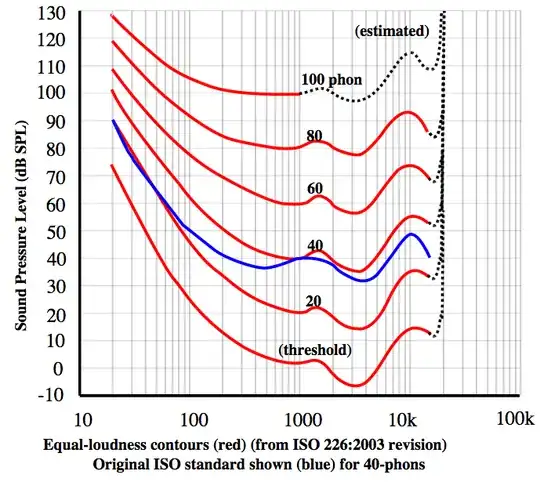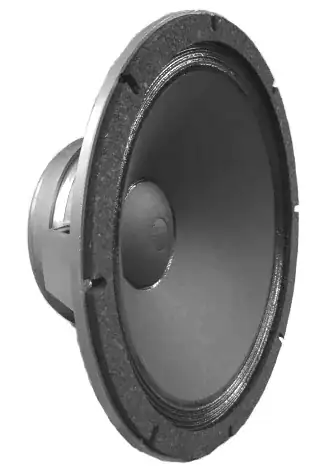I suggest a totally different approach. But it's only a partial approach with much guesswork, too.
The ear is able to perceive 20 µPa. (at 2 kHz). Of course you could calculate some pressure changes at the closing void, but these actually have nothing to do with the sound pressure at your ear drum.
Let's do some energy calculations. 20 µPa at 1 cm² area at your eardrum corresponds to $10^{-17} W$. Your ear needs $0.1 s$ integration time at this sound pressure to generate a usable signal.
So $10^{-18} J$ is the minimum energy which can be perceived.
A void will free some energy when collapsing. We can calculate the order of magnitude easily, if we assume a void of which one dimension is significantly smaller than the other two.
then the force acting on the big surface of the void calculates:
$F=p \cdot A$. The stored energy derives from the thickness $d$.
$E=d \cdot p \cdot A$
If we assume the pop happening direct in front of our eardrum directing all sound energy over the eardrum by generating only audible frequencies, we can calculate the absolute minimum size of the void.
This results in a void of $10^{-23} m³$ or $10^{-14} mm³$. which is in fact a very small volume.
Update: Estimations start here. The values above are hard limitations due to energy considerations. it is impossible to generate audible sounds with smaller imploding volumes.
Now we could start estimating how much bigger this cube has to be to compensate for most of the energy lost through
- distance between source and sink of the signal
- efficiency of converting potiential energy into sound in audible range
If that signal emerges 1 m from your ear you need 120000 times the energy, because your eardrum only catches the energy passing through $1 cm²$ of the surface of a sphere with 1m radius.
If you assume 1% efficiency, which is not uncommon for electrical speakers being much smaller than the wavelength which is desired to be emitted, the factor increases to 12,000,000. This sums up to $10^{-8} mm³$, which is a cube with $4.6 µm$ length or whatever exension you may derive from that.
Update These consideration has already some uncertainties.
- The thin void will produce a high directivity when collapsing. Hence, depending on the place of your ear, the factor 120000 will increase or decrease vastly.
- The expansion of the air into the void may happen really fast. Consider an average particle speed of 500 m/s and assume expansion with at least half that speed. with a thickness of approx. 0.1 mm (parchment) the void will close in 0.1 µs. When generously assuming twice the time for building up and depleting the pressure at the collision front, we get a pulse duration of 0.2 µs,
which yields a base freqency of 0.5 MHz.which will force a spreadened spectrum with much energy in high frequencies. (Floris in a comment noted correctly that a square pulse will always contain audible frequencies) Which means most of the generated sound energy will be really far from audible spectrum. This will be even worse if assuming such small voids as in my example calculation. So 1% conversion efficiency may be very optimistic. Efficiency concerning the audible freqency range only may be several orders of magnitude below 1%.
I guess it may be useful to take a closer look to the mechanisms of a collapsing void. I strongly oppose to a speaker membrane as a valid model for these mechanics, primarily because of the high mass of a speaker membrane.
Update I want to dive a little bit into the gas dynamics of the closing void. How is the air being accelerated when the void appears?
Initially there's a sharp border between 1 atm air and vacuum. Hence there's about 100000 Pa difference. Air molecules roughly have a mean distance of 33 nm and the first layer of molecules at that border is accelerated by the pressure. A single molecule uses an area of $0.9 \cdot 10^{-15} m²$. Therefore the force on that molecule is $10^{-11} N$. Assuming a molecule mass of 28 u (Nitrogen) the resulting acceleration is $1.9 \cdot 10^{15} \frac{m}{s²}$.
Let's further assume, the acceleration will rapidly decrease due to expansion to a thousandth of this to $1.9 \cdot 10^{-12} \frac{m}{s²}$. Then the void of 0.1 mm will close in 0.2 ns.
I have much doubt concerning this estimation because I have no idea how a front of pressurised gas in a vacuum really will behave. But I think the void will close with at least the speed of sound, perhaps even a lot of faster. Which again leads me to the assumption, that the very most of the energy will be converted to inaudible ultrasound.
Update I try to explain why I consider the speed of closing the void critical for audibility of the event.
If we consider the first estimation (closing of the void within 0.2 μs), and estimate some overshoot, which extends the duration of the event to 0.4 μs, we can do a fourier transform. (Kudos to Floris for this suggestion)
$\mathcal{F}(\operatorname{rect}(a t))(f)= \frac{1}{|a|}\cdot \operatorname{sinc}\left(\frac{f}{a}\right)$
with $a = 2.5 \cdot 10^6$ we get
$0.4 \cdot 10^{-6} \operatorname{sinc}\left(\frac{f}{2.5 \cdot 10^6}\right)$
The first zero crossing is at 400 kHz, which is an order of magnitude above the audible range which means we can assume a nearly flat spectrum in that range. If we try to integrate the power spectrum,
$\int\limits_{20}^{20000} 0.16 \cdot 10^{-12} \operatorname{sinc}^2\left(\frac{f}{2.5 \cdot 10^6}\right) df$
we better use an approximation, because neither sinc cannot be integrated analytically nor its square (please correct me if I'm wrong)
It yields roughly $\frac{20000}{2.5 \cdot 10^{6}}$ (but here I'm not so sure).
In my opinion this means, that only 0.8% of the signal energy will be in the audible range. If we confine the range to the most sensitive part around 2 kHz, assuming a reduced bandwidh of 1 kHz, the perceived energy declines to 0.04% of the whole signal.
If for the whole thing, the pulse length (time for collapsing the void) is reduced further, the audible part of the emitted sound energy declines as well.
more number juggling to come

